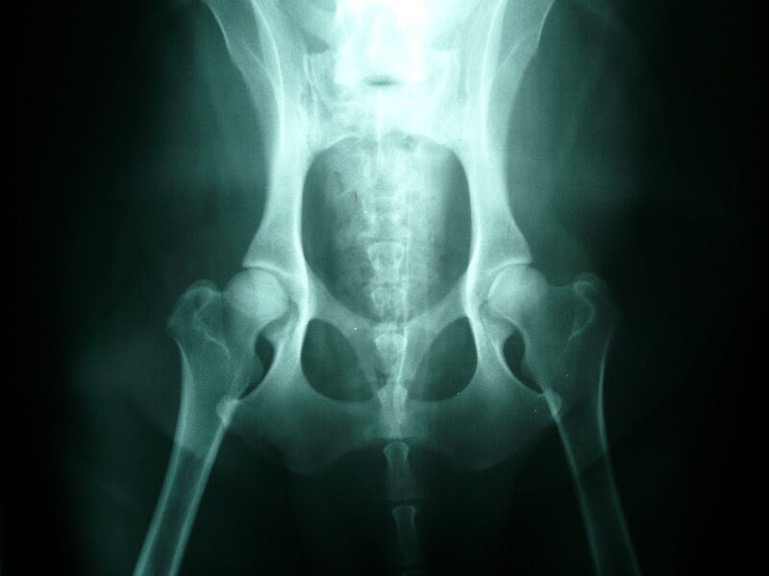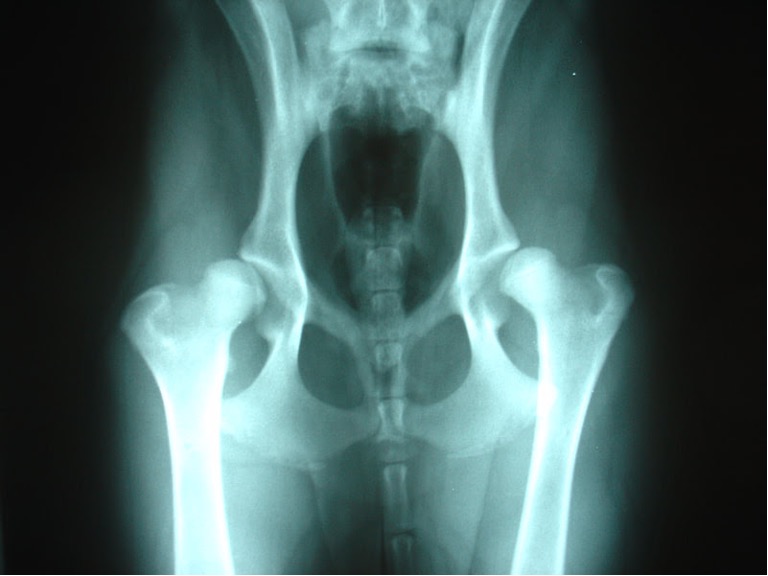Hip Dysplasia in Dogs

It is becoming very common to see hip dysplasia in many dogs of all breeds, predominately larger breeds. As a dog owner, you may feel absolutely devastated when the vet gives you the news but with advances in Veterinary treatment and safe conservative management options, hip dysplasia can be controlled and managed well.
What is Hip Dysplasia?
Hip dysplasia is a deformity of the hip joint that occurs during a dog’s growth period. Signs may be noticed as early as 4-6 weeks of age or not until they are in their senior years. The ball of the femur does not fit correctly into the hip socket which causes the hip to partially dislocate. Some dogs may show no signs of this condition where others will experience pain and difficulty moving around. Hip Dysplasia is mainly a genetic condition, however diet and the environment can contribute to this condition, such as obesity or rapid weight gain which puts excessive strain on the joints and nutritional disorders.
Signs to look for:
- Bunny hopping gait
- Hind leg lameness, stiffness or weakness
- Difficulty getting up or down on their beds
- Lack of co-ordination in hind quarters with swaying or staggering
- Reluctance to jump, run, go upstairs, play or exercise intolerance
- Change in behaviour
- Hind leg muscles deteriorate
- Pain in hip or pelvis area
- Dragging back paws or back nails worn down
How is Hip Dysplasia diagnosed?
Recognising symptoms early is important and your vet will do a physical examination by checking your dog’s movement of the hip joints and most probably taking x-rays to confirm the condition.
Normal Canine Hips

Bilateral Hip Dysplasia

What treatments are available for Hip Dysplasia?
There are many options available today when it comes to treating hip dysplasia and managing it. A treatment plan depends on various factors such as age and the severity of the condition. Surgery is normally a last option after other treatments and management have not been effective or if the condition is severe.
Non-surgical options
These include a combination of a healthy diet, weight management, joint supplements, anti –inflammatories, non-weight bearing exercise like hydrotherapy, to build muscle and support the limbs, acupuncture, photonic therapy and Osteopathic treatments.
Surgical options
There are several surgical options and your Vet will recommend which one is best suited to your dog’s condition.
Femoral Head Ostectomy (FHO)
The normal hip is a ball and socket joint and this surgery removes the neck and head of the femur which is the ball part of the joint. This surgery is very good, especially for smaller dogs as the muscles and connective tissue of the leg hold the femur in place and forms a functional “false joint”. FHO can be used in larger dogs if arthritis is severe, if the hip dislocates or if the other procedure is too expensive for the owner. FHO surgery can provide most patients pain free mobility.
Total Hip Replacement (THR)
Total hip replacement surgery removes both the ball and socket which is replaced with an artificial ball and socket normally made of surgical stainless steel and plastic. This is generally performed in larger breeds of dogs but can still be used in smaller dogs. THR surgery can give many years of pain free mobility and is generally reserved for dogs that have severe and painful conditions and that have not responded to conventional management.
Double or Triple Pelvic Osteotomy (DPO/TPO)
The object of the DPO and TPO procedure is to “capture” the femoral head in the socket thereby reducing laxity present. The procedure involves the pelvis being cut in two or three places around the hip joint, rotating the acetabulum and stabilising the pelvis in the new position with metal bone plates and screws.
This should only be performed on young dogs only - usually less than 6 months of age that have no arthritic changes in the joint. Following this procedure, dogs must be crated/confined for at least 6 weeks with short on leash walks only to ensure the bones heal in their new position correctly.
Caring for your dog with Hip Dysplasia
If you suspect that your dog has hip dysplasia, see your Vet straight away to minimise the arthritic changes that will develop as the problem worsens.
- Monitor your dog's body weight and avoid obesity as weight puts a lot of pressure on the joints.
- Avoid strenuous exercise but provide moderate low impact exercise such as hydrotherapy and controlled walks.
- Don’t over feed or over exercise growing pups. Researched evidence indicates that pups that grow too rapidly are more than likely to develop hip dysplasia and over exercising pups that may have any abnormalities in their hip structure will exaggerate the issue with excessive running, jumping and repetitively chasing objects. All of these can be detrimental to their growing joints.
K9 Swim can assist your dog in managing hip dysplasia with our state of the art Hydrotherapy and Wellness Centre. From our indoor heated pool, jet spa and under water treadmill for low impact and non-weight bearing exercise to our natural therapies, we can offer a range of treatments that will make a difference to the quality of life to your pet. If it's managing hip dysplasia with non-surgical options or rehabilitation after surgery, we can help your pooch get back on track to optimal health.
